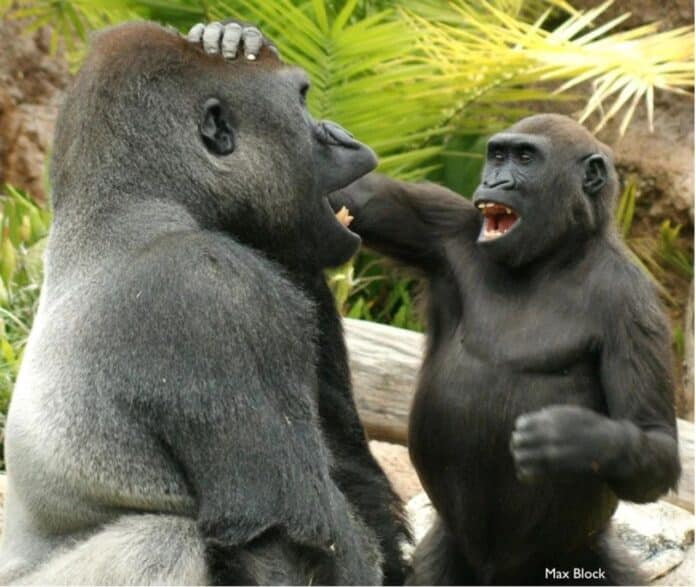Humor and laughter are essential for the flow of natural conversations. It acts as a facilitator of communication. Teasing has much in common with joking, and playful teasing may be seen as a cognitive precursor to joking.
Since language is not required for this behavior, similar playful teasing might occur in non-human animals. Now cognitive biologists and primatologists from the University of California Los Angeles, the Max Planck Institute of Animal Behavior (Germany), Indiana University, and the University of California San Diego have documented playful teasing in four species of great apes species: orangutans, chimpanzees, bonobos, and gorillas.
Scientists found that great apes, such as chimpanzees, gorillas, and orangutans, are excellent subjects for playful teasing. This is because they are closely related to humans, engaging in social play and laughter and demonstrating a relatively advanced understanding of others’ expectations.
The researchers examined natural social interactions among great apes that seemed playful, teasing, or mildly provocative. They carefully observed the actions, body language, facial expressions, and reactions of both the teaser and the target of the teasing. Additionally, they analyzed whether the teasing behavior was intentional, looking for signs that it was directed at a particular individual, continued or became more intense over time and whether the teaser awaited a response from the target.
The study revealed that orangutans, chimpanzees, bonobos, and gorillas exhibited deliberate provocative behavior, often coupled with playful elements. The researchers identified 18 different teasing behaviors, many of which seemed designed to elicit a reaction from others or to capture their attention.
UCLA and IU professor Erica Cartmill, senior author of the study, said, “It was common for teasers to repeatedly wave or swing a body part or object in the middle of the target’s field of vision, hit or poke them, stare closely at their face, disrupt their movements, pull on their hair or perform other behaviors that were extremely difficult for the target to ignore.”
“Although playful teasing took many forms, the authors note that it differed from play in several ways. Playful teasing in Great Apes is one-sided, very much coming from the teaser often throughout the entire interaction and rarely reciprocated. The animals also rarely use play signals like the primate ‘play face,’ which is similar to what we would call a smile, or ‘hold’ gestures that signal their intent to play.”
Playful teasing among apes mainly occurred when they were relaxed and shared similarities with behaviors observed in humans. Like teasing in children, ape teasing involves one-sided provocation, waiting for a response from the target, repeating the teasing action, and incorporating elements of surprise.
Laumer said, “Other field primatologists had mentioned similar behaviors happening in chimpanzees many years ago, but this new study was the first to study playful teasing systematically. From an evolutionary perspective, playful teasing in all four great apes and its similarities to playful teasing and joking in human infants suggests that playful teasing and its cognitive prerequisites may have been present in our last common ancestor, at least 13 million years ago.”
“We hope our study will inspire other researchers to study playful teasing in more species to better understand the evolution of this multi-faceted behavior. We also hope this study raises awareness of our similarities with our closest relatives and the importance of protecting these endangered animals.”
Journal Reference:
- Laumer I.B., Winkler S, Rossano F, Cartmill EA. Spontaneous, playful teasing in four great ape species. Proceedings of the Royal Society B. DOI: 10.1098/rspb.2023.2345
